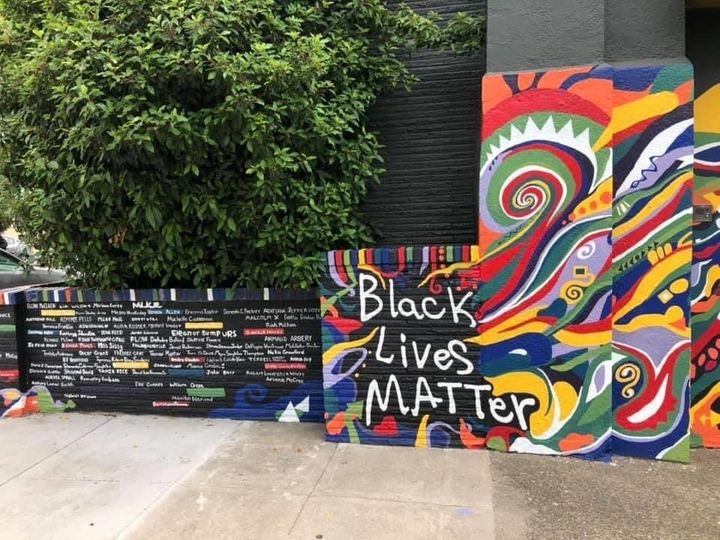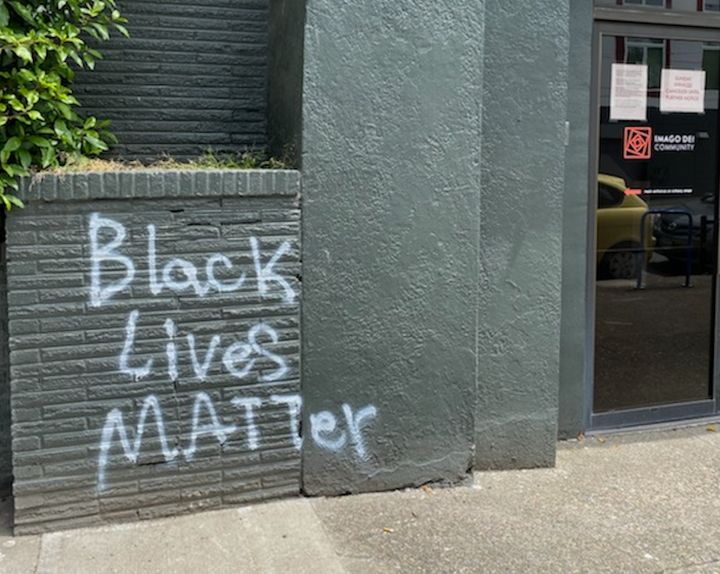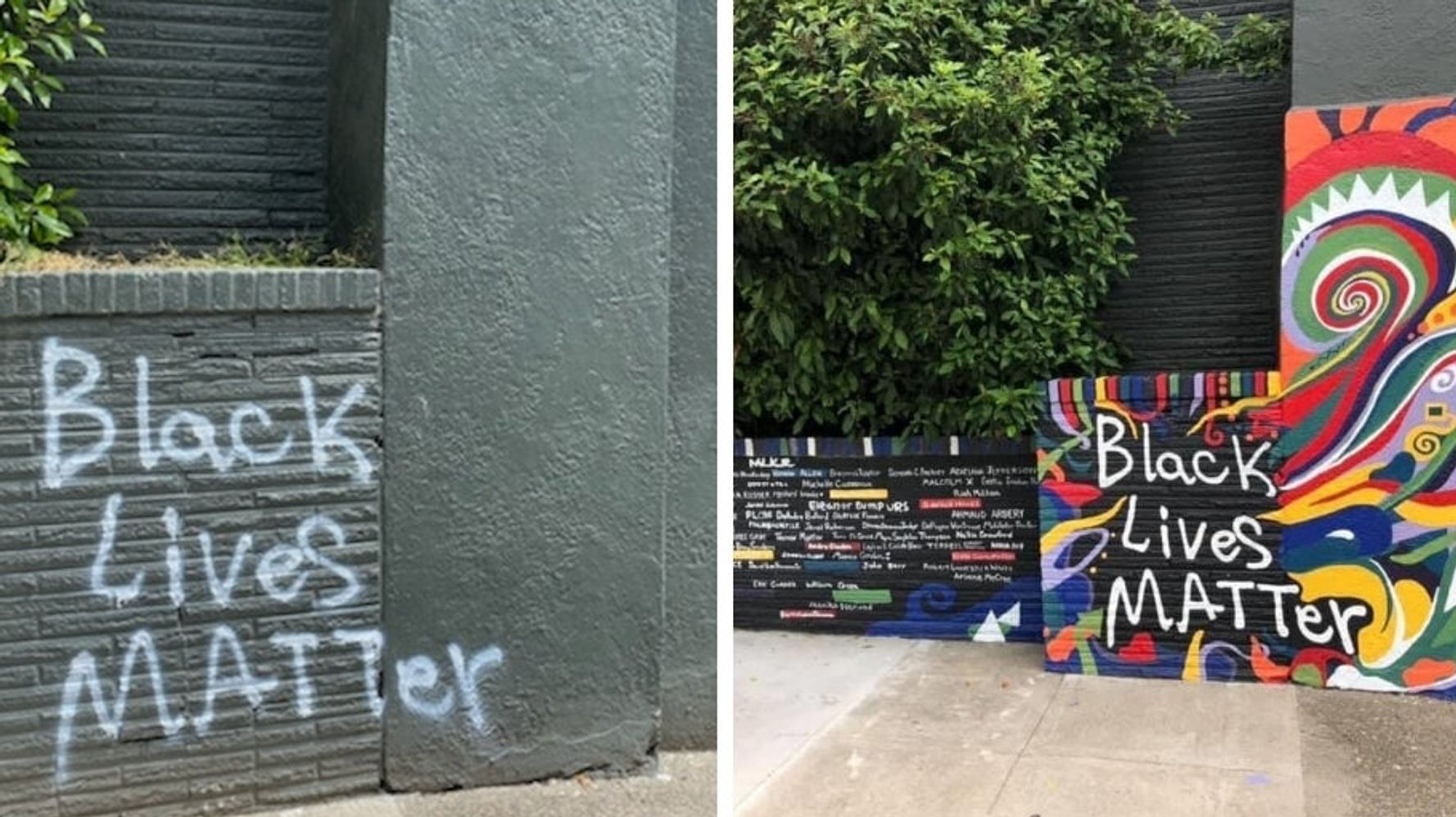[ad_1]
Usually, when the Portland, Oregon, church Imago Dei gets graffitied, the staff is quick to paint over it.
This time was different: On June 3, at the beginning of massive protests against police brutality in the city and across the nation, someone tagged “Black Lives Matter” near the front door of the nondenominational church on the southeast side of the city.
The next morning, the church staff’s message board was inundated with messages about what to do about the spray painting. A consensus came quickly, though: Why not turn it into a mural? After all, in recent years, the church hadn’t shied away from discussing racial injustice in sermons on Sunday. A mural fit perfectly into its mission.
“We didn’t want to paint over it because it felt like a ‘kairos moment,’ that rare window of opportunity when what you need to say aligns perfectly with a right time and a right way to say it,” associate pastor Michelle Jones told HuffPost.
One of the church’s staff members, Heidie Ambrose, is an artist. Ambrose quickly turned the simple graffiti scrawl into a vibrantly colored mural that traced over the original. To the right of the graffiti, individual bricks are painted with the names of victims of police brutality, racial injustice or white supremacy: Emmett Till, Breonna Taylor, Ahmaud Arbery, Martin Luther King Jr. and others.

In a sermon posted online, Jones called the decision a “real-world sermon example of choosing not to ‘paint over’ something that is very, very obvious” ― in this case, deep-seated racial inequity in this country and in the church.
More than two months since the building was tagged, the mural has become a neighborhood memorial. People take photos in front of. They even add forgotten or new names to the wall. Passersby tell church staff that talk of the mural has made its way to the dinner table.
“One mom said she had a ‘hard good’ talk with her two kids when her son asked, ‘Why are there so many names?’” Jones said. “And she had to tell him that there are actually more names than there are bricks to put them on.”
Imago Dei is one of a growing number of Christian churches that aren’t just concerned about personal relationships with Jesus; these days, they’re considering how Christ might lead and address the issue of racial injustice in America.
At the heart of it, church leaders are asking not only themselves but also their congregations: How does our reading of “Love thy neighbor” sync with the statement that “Black lives matter”?
Given the reluctance of some pastors to talk about race and racism, the shift in thinking is a long time coming, Jones said.
“The unfortunate truth is the church in America has historically stood by and watched silently as racism was allowed to take root and then bear fruit for centuries,” she said. “Local churches often actively participated in the establishment and perpetuation of segregation and white supremacy in their communities.”
American Christianity and white supremacy have long been intertwined: From the pulpit, white pastors defended slavery and Jim Crow laws through interpretations of scripture. When the civil rights movement picked up steam in the 1960s, whites in the church remained largely silent. (In 1995, the Southern Baptist Convention passed a resolution condemning the denomination’s role in promoting racial bigotry and apologizing to “all African Americans” for condoning “individual and systemic racism in our lifetime,” whether “consciously or unconsciously.”)
But for many white evangelicals, indifference to racial inequity continues today. As of 2018, 71% of white evangelicals believed that incidents of police officers killing Black men were isolated and not part of a broader pattern, according to a survey from the Public Religion Research Institute.
It’s an inward problem, too. As NPR reported, 20 years ago, Michael Emerson, a sociologist at Rice University, directed a study of efforts by white evangelical Christians to address racial inequality. Emerson found that evangelicals “likely do more to perpetuate the racial divide than to tear it down,” as he summarized in his book “Divided by Faith.” That’s in large part because congregations have remained racially segregated and have continued to view racial prejudice as an individual failure, not a societal problem worth addressing, according to Emerson.
“Until and unless we the church are willing to tell the truth about race and racism in America, we will never rise above it or have the credibility to help others do the same.”
– Associate pastor Michelle Jones, Imago Dei church in Portland, Oregon
In a recent Imago sermon, “We Are the Church,” Jones quoted N.T. Wright, a former Anglican bishop and an English New Testament scholar, who said that racism in the church should be considered a “devastating oxymoron.”
“We continue to struggle to see our neighbors and ‘de-other’ people who are different when we should be leading the charge to love,” Jones told HuffPost. “We have to own that. Until and unless we the church are willing to tell the truth about race and racism in America, we will never rise above it or have the credibility to help others do the same.”
That call feels especially poignant in Portland, a city that has been called “the whitest big city in the country.” Portland may have a modern image as a progressive mecca, but it also has a dark, oft-overlooked history of racism.
With these heavy histories in mind, the Imago staff, led by pastor Rick McKinley, has been intentional about making racial injustice a gospel issue. In recent years, they’ve hired people of color in leadership positions in an effort to build a multicultural church (“That’s how they found me!” Jones joked).

When a national conversation broke out about the separation of families at the border two summers ago, Imago did a series on immigration, with leaders of the church going to Texas to be able to provide an update on the situation.
“We explored what it meant to be an immigrant from a biblical perspective as well as the immigration issue as a whole,” said Justin Zoradi, a congregant whose Instagram post on the BLM mural was widely shared.
“We’ve discussed policing, gentrification and prison reform to the point where I’m sure it’s been uncomfortable for some people,” he said.
Jones confirms that some in the church felt uneasy about the more social justice-minded sermons, especially prior to COVID-19 and the recent protests.
“People might want to talk after an uncomfortable sermon, saying it was ‘too political’ or ‘too angry’ or too something,” she said. “But I like those conversations. Even when they aren’t easy, they’re good.”
The mural is part of this often difficult, ongoing project. And as the conflict over the last month in Portland between federal agents and protesters has intensified, the artwork feels even more necessary, Jones said.
“At Imago, we’re trying to keep the main thing the main thing,” she said. “I think that’s also why the mural is there ― to remind those who see it that with so many things happening at the same time, justice matters. These people on this wall ― and people like them ― matter.”
Leaders at the church hope the mural will continue to speak long after the protests are over and the news moves on to the next big thing. As the fight continues, Jones said she keeps the faith by remembering her favorite Martin Luther King Jr. quotes ― a passage from King’s final work, “Where Do We Go From Here: Chaos or Community?”
“MLK wrote, ‘Every society has its protectors of status quo and its fraternities of the indifferent who are notorious for sleeping through revolutions. Today, our very survival depends on our ability to stay awake, to adjust to new ideas, to remain vigilant and to face the challenge of change.’”
[ad_2]
Source link

